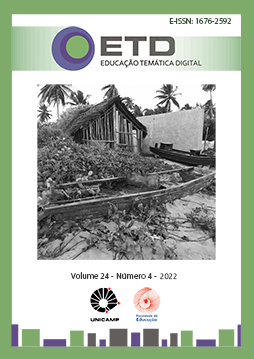Resumo
Em 1985, o Ministério da Educação da Venezuela iniciou o Modelo de Atención Integral al Niño Sordo, uma mudança da prática oralista para um modelo bilíngüe nas escolas para surdos. Isto envolveu eliminar o ensino do espanhol falado como objetivo principal, bem como introduzir a Língua Venezuelana de Sinais (LSV) nas escolas. Isso desencadeou um intenso período de mudanças que marcou indelévelmente a comunidade surda. O Modelo é abordado aquí a partir da perspectiva do planejamento lingüístico, descrevendo seus objetivos e seus efeitos na aquisição, estrutura (o corpus) e status da LSV: LSV e espanhol sinalizado foram realocados na diglossia que existia até então; uma variante acadêmica do LSV surgiu e o número de usuários do LSV aumentou. O estudo foi baseado na análise qualitativa de entrevistas com cinco testemunhas desse processo.
Referências
ANZOLA, Myriam. El modelo de educación bilingüe para el niño sordo: La experiencia de Mérida. Fermentum, v.2 n.5, 1992, p. 81-93.
CHARMAZ, Kathy. Constructing grounded theory: a practical guide through qualitative analysis. Londres: Sage Publications, 2006, 224 p.
COOPER, Robert L. Language planning and social change. Cambridge. Cambridge University Press, 1989, 216 p.
DE FINA, Anna. Researcher and informant roles in narrative interactions: Constructions of belonging and foreign-ness. Language in Society v. 40, 2011, p. 27–38.
DE MEULDER, Maartje; MURRAY, Joseph J; y MCKEE, Rachel. The legal recognition of sign languages: advocacy and outcomes around the world. Sidney: Multilingual Matters, 2019, 352 p.
FISHMANN, Joshua. Bilingualism with and without diglossia; diglossia with and without bilingualism. Journal of Social Issues v. 23, n.2, 1967, p. 29–38.
GULATI, Sanjay. Language deprivation syndrom. En: GLICKMANN, Neil; HALL, Wyatte (Ed.). Language deprivation and deaf mental health. Nueva York: Routledge, 2019, p. 24-46.
HOLCOMB, Roy K. Education, History of Total Communication. En: GERZT, Genie; BOUDREALDT, Patrick (Ed.). The SAGE Encyclopedia of Deaf Studies. London: SAGE, 2016, p. 342-343.
LADD, Paddy. Understanding deaf culture. In search of deafhood. Sydney: Multilingual Matters, 2003, 502 p.
MARSCHARK, Mark; SPENCER, Patricia E. (Ed.). The Oxford Handbook of Deaf studies, language, and education. Oxford University Press, 2010, 505 p.
MATHUR, Gaurav; NAPOLI, Donna Jo (Ed.). Deaf around the world: the impact of language. Oxford University Press, 2010, 400 p.
MORALES GARCIA, Ana María. Algunas consideraciones para la implementación de políticas educativas para los sordos en Venezuela. Cultura Sorda, 2006. Disponible en: https://cultura-sorda.org/biblioteca/articulos/educacion/#2006 . Visto el 02/12/2022.
MORALES GARCIA, Ana Maria; PEREZ HERNANDEZ, Yolanda. Bicultural bilingual deaf education in Venezuela: approaching a necessary debate. En: GERNER DE GARCIA, Barbara; KARNOPP, Lodenir Becker (Ed.). Change and promise: bilingual deaf education and deaf culture in Latin America. Washington, DC: Gallaudet University Press, 2016, p. 193-209.
OVIEDO, Alejandro. 1996. Bilingual deaf education in Venezuela: linguistic comments on the current situation. En: LUCAS, Ceil (Ed.) Multicultural aspects of sociolinguistics in deaf communities. Washington D.C.: Gallaudet University Press, 1996, p. 61-77.
OVIEDO, Alejandro; RUMBOS, Henry; PEREZ HERNANDEZ, Yolanda. Los estudios sobre la LSV. En: FREITES, Francisco; PEREZ, Francisco (Ed.) Las disciplinas lingüísticas en Venezuela. Maracaibo: Universidad Cecilio Acosta, 2004, p. 201-33.
PEREZ HERNANDEZ, Yolanda. Los marcadores en LSV. Caracas: UPEL, 2009, 186 p.
PIETROSEMOLI, Lourdes. La LSV: análisis lingüístico. Mérida: ULA, 1991, 182 p.
SANCHEZ, Carlos. La increíble y triste historia de la sordera. Caracas: CEPROSORD, 1990, 126 p.
SANGARISAVAM, Yamuna. Researcher, informant, "assassin", me*. The Geographic Review, v.91, n.1-2, 2010, p. 95-104.
SENGHAS, Ann; KITA, Sotaro; ÖZYÜREK, Asli. Children Creating Core Properties of Language: Evidence from an Emerging Sign Language in Nicaragua. Science, v.305, 2004, p. 1779-82.
SIINER, Maarja; HULT, Francis M.; KUPISH, Tanja (Ed.). Language policy and language acquisition planning. Cham: Springer, 2018, 255 p.
TOLLEFSON, James W.; PEREZ-MILANS, Miguel (Ed.). The Oxford Handbook of language policy and planning. Oxford University Press, 2018, 656 p.
VENEZUELA. Conceptualización y política de la atención educativa integral del deficiente auditivo. Caracas: Ministerio de Educación, 1996, 52 p.
WOLL, Bencie; LADD, Paddy. Deaf Communities. En: MARSCHARK, Mark; SPENCER, Patricia E. (Ed.) The Oxford Handbook of Deaf studies, language, and education. Oxford University Press, 2010, p. 151-63.

Este trabalho está licenciado sob uma licença Creative Commons Attribution-NonCommercial-NoDerivatives 4.0 International License.
Copyright (c) 2022 ETD - Educação Temática Digital


